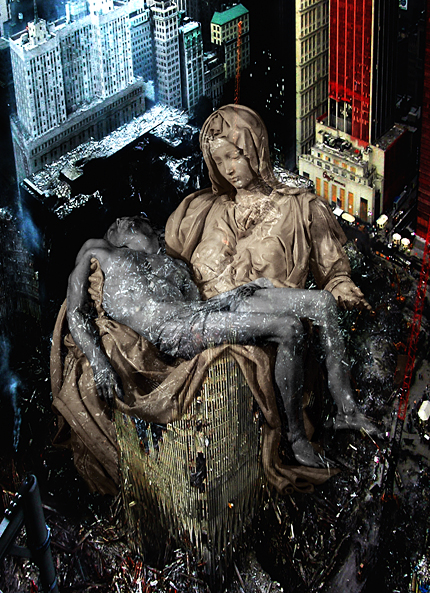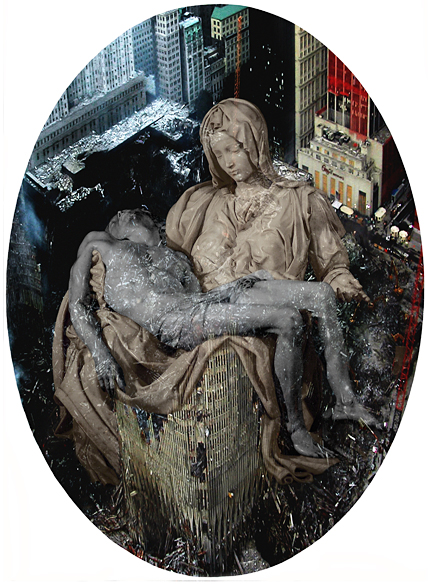OMM Project Annex: David Colantoni
|
Reflections on the “Pietà in Ground Zero” By David Colantoni In this work I have united two distinct moments in the human experience: one, creation, and the other, destruction; a work of art, and an act of violence. The perspective of this work is a Herodotean one. It is asentimental, historical, and is limited to the contemplation of the two things at the level of a detached blending of the two elements, without daring to formally make any comment that goes beyond that which is evident in the superimposition of one image upon another (this work may also be a psychic self-portrait). It is a work which represents man as being at the same time capable of grandiose creation and grandiose destruction. And it demonstrates the paradox of the terrible as something which is able to esthetically impact human perception, that terrible Ibsenian element that fatally draws one to the fulfillment of their destiny. Reflecting upon the work, I realized that Christ himself is a terrible work of human destruction. And art has fed off this terrible destruction for centuries, metabolizing or transcending it in its own beauty. Thus the art exercises a process of salvation in the esthetic unity of the tragedy of destructive energies that man unleashes on himself, because for me Michaelangelo’s Pieta has the cathartic force of a Greek tragedy. The art freezes in its beauty the unconsumed residue of human suffering. I think of the slow opening panoramic shot of ruined Berlin in “Germany Year Zero” by Roberto Rossellini. Beauty as the redemption of the irreconcilable nature of the terrible. There is also an entropic exchange between the two imago. I believe this is the reason for which I followed my instinct in making the Christ figure transparent, so that Michaelangelo’s marble would incorporate into its fabric the remains of the destroyed towers. At the same time this incorporation, an iconic condensation, refers to the assumption of earthy sins which are resolved in the physical destruction of Christ’s terrestrial life, offered in exchange for the redemption of humanity. At this point the concept of mercy, for me, can be channeled and read in different ways. It can mercy as a human emotion applied to the event of the towers as a total paradigm of “ground zero”, to which the contemporary human condition is added, devastated by the inextricable vortex of the meaning of a history that can take the most unthinkable turns. It can also be read as mercy which has itself reached the end of its capability, which Hannah Arendt identified as forgiveness, as the sole human action able to stop the chain of consequences provoked by human violence and able to start the world anew. In this work, chance is presented as the ontic conjunction between the two imago, and is similar to fortuitous coincidence, but rich with the metaphysical significance that is often evidenced in classical stories by the human invocation of a divine sign, and the purely casual coincidence of a natural event. In this case the sign of reciprocal metatemporal belonging between the two imago, has been, for me, the discovery of the nearly perfect coincidence between the form of the remains of the twin towers and the form of the Madonna’s skirt. Like a shared identity that is concealed away in the various protagonists of a dream, that which remains of the towers seems to be made of the same unconscious material as the Pietà, and this allowed me to stylistically unite the two imago. But these are merely a posteriori reflections on my work, on my attempt to create a dialectic relationship between two icons of the global visual koinè. Just as Benjamin predicted when he observed that perhaps surrealism did not seek to escape from dreams, and that he would have considered the creation of dialectic images capable of waking and penetrating the real an important evolution of the premises of surrealism itself, a theme to which he promised to reflect upon and which his tragic suicide left as the only indication to future artists and thinkers. As regards the motivation for the work as a whole, one thing is clear: rather than making my own personal mark within the expositive space, which is to say my own painting, an opposite type of space has been created thanks to the absence of any brush strokes that are recognizable as my particular style. It is a space whose direction is towards the exterior of the exposition itself, inviting the public to look through the oval, like a window, into the history of the world. In this case it is the political history represented by the towers and the relationship that art must necessarily have with them, represented here by Michelangelo’s Pietà which, like all sacred art, is also a symbol of this relationship between art and history, as well as with the divine. Translated from Italian by Ashleigh Rose |



